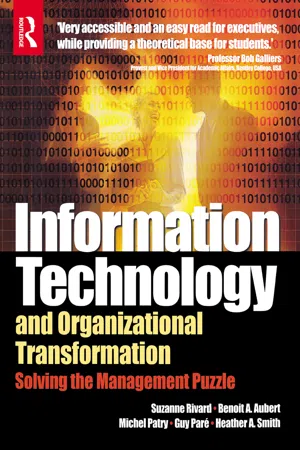Business
Challenges of Management
The challenges of management encompass various aspects such as leadership, decision-making, communication, and resource allocation. Managers often face obstacles related to organizational change, employee motivation, and achieving strategic goals. These challenges require effective problem-solving skills, adaptability, and the ability to navigate complex and dynamic business environments.
Written by Perlego with AI-assistance
Related key terms
Related key terms
1 of 4
Related key terms
1 of 3
5 Key excerpts on "Challenges of Management"
- Benoit Aubert, Suzanne Rivard, Michel Patry, Guy Pare, Heather Smith(Authors)
- 2004(Publication Date)
- Routledge(Publisher)
PART IV
The management challenges
Organizing a business is similar to putting together a puzzle; it all comes down to execution. The frame may be right, the picture clear, and the pieces carefully selected, but if the puzzle cannot be pieced together or the pieces do not fit properly, then you have nothing but an assortment of pieces. Unlike jigsaw puzzles, how-ever, the management puzzle does not have carefully machined pieces with edges that are designed to interlock closely. Instead, it must be put together with the skills, techniques, and practices that enable each part of the business to connect seamlessly and present a coherent picture to the outside world. It is the execution capabilities of the organization's managers that enable the strategy, structure, information Technology, and leadership pieces to work together smoothly and effectively in a given environment. These capabilities are created in four ways – people management, IT management, knowledge management, and change management (Figure IV.I ).Like everything else in the management puzzle, the manager's job in today's organization has become much more complex and challenging. Only a few years ago, the staff of most organizations consisted of full-time, dedicated employees and a few contract staff. While people and work are still essential to execution, today it is a radically-changed world for both workers and their managers. Staffing options such as outsourcing, telecommuting, partnerships, alliances, and a global workforce (to name just a few), are all being used by companies as they grapple with the economic challenges and technology choices confronting them. New organizational structures and interorganizational projects mean that staff may be reporting to not one, but several, different managers. Through information and telecommunications, staff can now work anywhere, anyplace, and anytime. Thus, the very nature of work is changing. The managers of the next decade will be pioneers in creating an environment to obtain maximum value and productivity from all staff, wherever they are located and whatever their employment status.- eBook - ePub
- Colin Egan(Author)
- 2012(Publication Date)
- Routledge(Publisher)
3
The strategic and organizational challenges of a turbulent business environment
Introduction
Economists and writers on strategic management draw attention to different levels and dynamics of change in the business environment in which firms operate. In periods of relative stability the factors which characterized previous years’ business conditions are good predictors of future developments and the process of planning and managing the business can draw heavily on past experience. By contrast, when the business environment demonstrates ‘discontinuous change’ the management task becomes far more complex. Under these conditions independent environmental factors are changing in an unprecedented manner and, worse still, the dynamics between the factors are changing at the same time.Environmental turbulence, complexity and change
The environment of any large organization encompasses an elaborate set of dynamic interactions, including economic, legal/political, competitive, technological, geographic, social/cultural and demographic variables, each of which will vary in importance and impact for individual firms and industries and will take on more or less significance at different periods of time. The business environment can be usefully subdivided into macro and micro variables to assist analysis, although it should be acknowledged that the influence, intensity and impact of such sub-environment forces will tend to be interdependent rather than independent. Figure 3.1 shows a typical representation of the business environment.Figure 3.1 The business environmentThe key point to note is that a firm has very little control over those environmental variables external to it. So, for example, it has no influence over economic, legal, political, social and cultural factors. In its micro environment a company has little control over competitors, suppliers, intermediaries or regulators. The immediate conclusion to draw from this is that a firm’s success will depend upon its ability to maximize the effectiveness of those factors over which it has full control, i.e. its strategic choices and management processes. An equally immediate concern for companies is that such decisions and how it implements them will have a context riddled with risk and uncertainty. - eBook - ePub
Engineering Management
Meeting the Global Challenges, Second Edition
- C. M. Chang(Author)
- 2016(Publication Date)
- CRC Press(Publisher)
11.1 IntroductionIntroduction to Management Challenges for EngineersIn our modern-day economy, customers’ needs are changing rapidly, the marketplace is becoming global, and technology is advancing at an ever-increasing speed. To maintain competitiveness in such a challenging environment, companies need effective leaders who understand both technology and business. Engineers with proper management training have great opportunities to make valuable and lasting contributions (Chang 2005; Merino and Farr 2010).In industry, managers are select employees entrusted with the responsibilities of putting communications means to use, making critical decisions, taking decisive actions, applying resources, and guiding the behavior of internal teams and external business partners to achieve company objectives (Shah 2012; Gomez 2014).The communications means applied by managers may be verbal or written, with or without body language. The decisions made take into account technical feasibility, resources conservation, and economic viability. The actions taken include planning, organizing, leading, and controlling. The resources utilized involve people, time, capital, equipment, facilities, technology, know-how, and business relationships. The teams guided by managers are individual employees (teams of one), projects, task forces, quality circles, and others. The external business partners may include customers, suppliers, networked partners, and joint ventures or otherwise aligned companies. For individual science, technology, engineering, and math (STEM) professionals to succeed in such an environment, they need to heed the advice of Henry Ford, who said, “The only real security that a man can have in this world is a reserve of knowledge, experience and ability.”This chapter starts with a brief review of the major sectors of a national economy. Then, it discusses the work of engineering managers and practicing engineers, and delineates the differences between these two types of work. Finally, the chapter addresses the challenges faced by engineering managers in the global environment. - Franz Schmithüsen, Bastian Kaiser, Albin Schmidhauser, Stephan Mellinghoff, Karoline Perchthaler, Alfred Kammerhofer(Authors)
- 2015(Publication Date)
- Routledge(Publisher)
4 Management, human resources and organisation4.1 Management as an entrepreneurial challenge
4.1.1 Management systems
Management is generally understood to refer to the shaping, guidance and development of sociotechnical systems using professional methods. Targeted business processes need to be organised, developed and guided by management. Organising a process means creating realistic management systems. Development refers to continuing adaptation of these systems to a changing business environment. Guidance means setting goals as well as planning, executing and controlling entrepreneurial activities. Modern business management thus requires forward-looking decisions, based on today’s information and entrepreneurial tools, and continuous review of the effectiveness of prior decisions. The term management is used in an institutional sense to refer to the individuals who carry out management tasks. In large companies, management is divided into higher, middle and lower management (Drucker 1954, 1974; Drucker and Haas-Edersheim 2007).Business management deals with multilayered problems within a complex, often unpredictable, environment. It requires a willingness to engage in a continual learning process and take entrepreneurial risks. It presupposes an ability to quickly recognise and evaluate changes both in the company and in its business environment. In this sense, management is an important prerequisite for deliberate entrepreneurial action. A qualifying and motivating factor in the work of active, self-confident managers is the search for innovation. Management above all means having a talent for leadership and for persuading employees to develop cooperation and implement shared goals making the company successful.- Mathew Donald(Author)
- 2019(Publication Date)
- Emerald Publishing Limited(Publisher)
The remainder of this chapter will discuss the various aspects of management in the context of the modern new age involving both disruption and artificial intelligence (AI). These aspects of management are not likely to disappear in the new age, although the concept application may alter. The very nature of management as a concept of delivering controlled and dependable outcomes to stakeholders, may be seriously challenged in the new age as the future may be an environment of fast paced and unreliable information.Strategic Management
Organisations are built upon processes and resources, where goal alignment is necessary to prevent confusion and inefficiency. Strategy may have emerged over 2,000 years ago based on skills of administration, power, communication and leadership (Mainardes, Ferreira, & Raposo, 2014; Quinn, Mintzberg, & James, 1988). Whilst strategy can be disunited, it has been successful (Nag, Hambrick, & Chen, 2007) and is often used by organisations to develop long-term goals. The topic emerged in the last 40 years, derived from a number of fields including finance, marketing and economics, where disparities remain on the definition (Hambrick, 2004; Nag et al., 2007). Strategy definitions may require amending as students have found it a difficult concept to apply (Mainardes et al., 2014), where it has been described as being the conduit between the inner organisation and the outside world (Mainardes et al., 2014). The topic is concerned with the long-term survival and growth of the organisation rather than the many other management aspects (Bao, 2015). It is also important to assess and understand existing strategic management systems prior to introducing new systems (Melander, Löfving, Andersson, Elgh, & Thulin, 2016).The process of setting strategy varies between organisations, where some update the strategy annually and others less frequently, some set a strategy for a next five-year horizon, whilst others set it for 10 years. The process may start differently in various organisations, where strategy may be described as having five elements and the plan arising is aimed at gathering competitive advantage (Mintzberg, 1987). The mission and vision statement for an organisation is often an area where the planning may commence, descriptions and forecasts reviewed for the potential competition type and the competitive advantage. The forecasts are rarely unique or in a single direction in the early phases, as there may be alternate paths and scenarios to rate before deciding on a particular one to use in the more formal strategic plans.
Index pages curate the most relevant extracts from our library of academic textbooks. They’ve been created using an in-house natural language model (NLM), each adding context and meaning to key research topics.
Explore more topic indexes
Explore more topic indexes
1 of 6
Explore more topic indexes
1 of 4




